Research Topics
1. Catalytic compartments: Complex reactions in confined spaces at nano- and micro-scale
2. Self-organization of nano-assemblies in controlled architectures
3. Active surfaces
4. Bio-hybrid compartments with improved properties
5. Artificial organelles and cells
6. Bio-hybrid assemblies for biological applications
7. Development of polymeric self-assemblies and networks for biomedical and industrial applications
8. Zipping of Synthetic Assemblies Equipped to Produce Multifunctional Clusters for Bio-Applications (NCCR Molecular Systems Engineering)
1. Catalytic compartments: Complex reactions in confined spaces at nano- and micro-scale
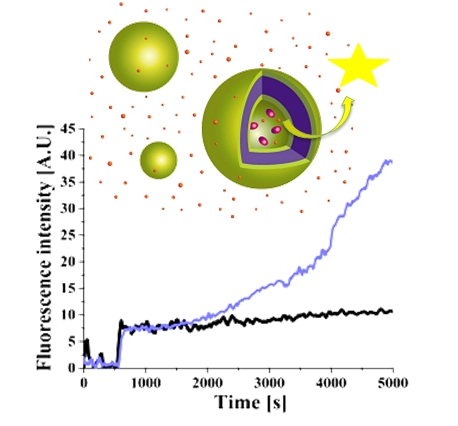
In order to understand and mimic reactions taking place inside cells, we develop catalytic compartments by encapsulating active compounds (enzymes, proteins, mimics) inside synthetic compartments and inserting membrane proteins in their walls. The active compounds freely move and act inside the cavity of the compartment, which protects them from destructive environmental conditions, while the membrane proteins serve as “gates” allowing the free passage of substrates and products through. Catalytic compartments can be designed to act in tandem and support cascade reactions, which produce a desired compound or mimic sections of metabolic pathways. Such catalytic compartments act as nano- or micro-reaction spaces for a large variety of applications ranging from catalysis or storage of oxygen up to controlled production of drugs, or detoxification of harmful oxygen species involved in oxidative stress.
2. Self-organization of nano-assemblies in controlled architectures
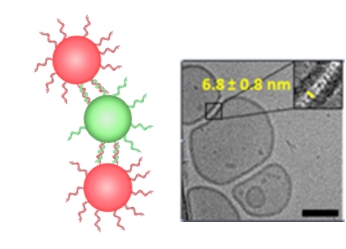
Our aim is to hierarchically self-organize synthetic assemblies with nanometer size, such as polymersomes, into clusters with controlled properties and topology by exploiting molecular recognition interactions (e.g. DNA hybridization, or biotin-streptavidin pairs) to interconnect them. Polymersome clusters mimic the connection of natural organelles inside cells and interact differently with each cell line depending on the molecular- and external factors affecting their self-organization. Such polymersome clusters loaded with enzymes will support complex reactions as a fundamental step for development of artificial systems mimicking natural cells or tissue. This platform of self-organized nano-assemblies has a high potential for biological applications, such as protein therapy or active templates for regenerative medicine.
Contact
3. Active surfaces
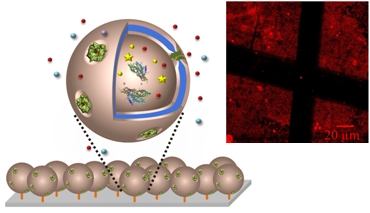
We are developing a platform of active surfaces with specific functionalities and high efficacy by immobilization on solid support of synthetic templates (membranes and assemblies) containing biomolecules. The aim is to obtain active surfaces with functionality resulting from the intrinsic activity of the biomolecules, while the stability and robustness of the bio-hybrid material is provided by the synthetic template. Such active surfaces are intended for a large variety of applications: controlled production of desired compounds (e.g. antibiotics), fighting against bacterial growth on implants, sensing fine changes in the environment (e.g. pH changes associated with early change of food quality or the presence of specific molecules) or degrading traces of harmful compounds (e.g. for high purity water).
Contact
Dr. Mirela Malekovic, Maryame Bina
Collaborations
Prof. Dr. Konrad Tiefenbacher, University of Basel
4. Bio-hybrid compartments with improved properties
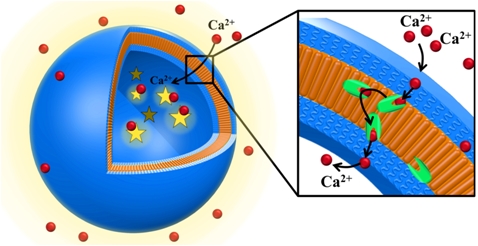
We use a bio-inspired approach to obtain synthetic compartments with new properties by decorating them with wild type or chemically modified biomolecules that preserve their intrinsic function in the synthetic environment. Impermeable, synthetic compartments gain specific permeability when biopores are inserted in their membrane, or triggered permeability when bio-valves are associated. Attachment of specific molecules at the external interface of compartments improves their up-take by cells. Such bio-hybrid compartments with improved properties provide new solutions with enhanced control and precision at the nanometer scale for technological (e.g. water purification) and biological applications (e.g. biosensing, signaling, controlled release of drugs).
Contact
Dr. Cora-Ann Schönenberger, Dr. Gloria Saorin, Anamarija Nikoletić, Piotr Jasko
Collaborations
Prof. Rod Lim, University of Basel
Prof. Mark Sansom, Oxford University, UK
Prof. Dirk Schneider, Johannes Gutenberg-University Mainz, Germany
Prof. Gebhard Schertler, Paul Scherrer Institute
PD Dr. Richard Kammerer, Paul Scherrer Institute
5. Artificial organelles and cells

Our aim is to design and develop the closest-to-nature artificial organelles and cells as novel systems to provide multifunctionality and complexity in biological applications. We advance in two complementary directions: i) we create artificial organelles mimicing the natural ones (e.g. peroxisome) by encapsulating/inserting biomolecules in artificial compartments to render them multifunctional and ii) we generate artificial cells by inducing formation of giant plasma membrane vesicles from donor cells that simultaneously transfer various bio- and synthetic entities inside. We develop artificial organelles and complex artificial cells that are non-toxic, and preserve their functionality in vitro and in vivo when injected in animal models. These systems open new avenues to advance patient oriented diagnostics and therapy.
Contact
Dr. Cora-Ann Schoenenberger, Dr. Xinan Huang, Dr. Gloria Saorin
Collaborations
Prof. Jörg Huwyler, University of Basel
Prof. Viola Vogel, ETHZ
6. Bio-hybrid assemblies for biological applications
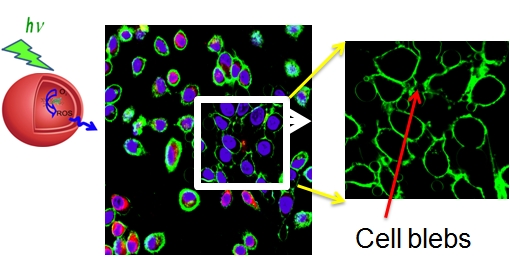
We develop a platform of bio-hybrid assemblies by entrapment/encapsulation of active compounds inside synthetic assemblies made of polymers, peptides and combination of thereof. The aim is to develop new solutions for diagnostics and therapeutics with improved efficacy, controlled functionality and local precision. Various assemblies, such as nanoparticles, polymersomes, or complex micelles serve as hosts for a variety of compounds ranging from drugs, contrast agents, photosensitizers up to proteins or DNA. Active compounds are either kept inside the assembly where they preserve the functionality (e.g. production of single oxygen for photodynamic therapy, improvement of contrast for MRI) or are released in specific conditions (e.g. pH or reductive changes in the environment).
Contact
Lukas Heuberger, Dr. Shabnam Tarvirdipour, Dr. Voichita Mihali
Collaborations
Prof. Yakoov Benenson, ETHZ
Prof. Catherine Housecroft, University of Basel
Dr. Lev Weiner, Weismann Institute, Israel
Prof. Abhay Pandit, Galway University, Irland
Prof. Martin Malmsten, Upsalla University, Sweden
7. Development of polymeric self-assemblies and networks for biomedical and industrial applications

1. Bishydrophilic block copolymer, 2. Amphiphilic AB block copolymer, 3. Amphiphilic ABC block copolymer 4. Tree block copolymer, 5. Star block copolymer, 6. Comb block copolymer, 7. 3D elastomers, 8. Amphiphilic oligopeptides.
Amphiphilic block copolymers are able to self-assemble in aqueous media into several morphologies such as spherical micelles, cylindrical micelles (worms) and vesicles (polymersomes). The latter ones (micro- or nanometer-sized hollow spheres with a polymer membrane) are of special interest for biomedical applications, including drug delivery, nanoreactors, cell mimics or theranostics. In this respect, we synthesize novel biocompatible amphiphilic di- or triblock copolymers, employing different polymerization methods such as radical (ATRP, RAFT), ionic (anionic and cationic ROP) and metal-catalysed polymerizations (ROMP). Hence, offering a large variety of chemical features, functionalities and properties. Our expertise lies in the development of polymer systems that enable the insertion of biopores into the membrane and the encapsulation of biologically relevant substrates (enzymes), the most prominent example being PDMS-b-PMOXA.
Specific functions are targeted by using stimuli-responsive blocks that react to light, temperature, redox potential or pH changes, or by end group modification with several moieties. Self-assembly of aforementioned copolymers leads to the formation of nanoparticles that can be loaded with cargo and release the it upon external stimuli such as delivery of glucose using pH responsive polymersomes, with dyes, DNA, or other target groups for various biomedical applications.
Additional competences involve the development of polymeric pervaporation membranes based on the synthesis of tailor-made block copolymers, the study of their different morphologies during self-assembly and the correlation with the membrane transport properties as well as on the syntheses of anisotropic hydrogels based on simple building blocks and the investigation on their mechanical properties and finally, on polymer networks such as ion responsive microgels and fibres allowing potential applications in actuation and tissue regeneration.
Social Media
